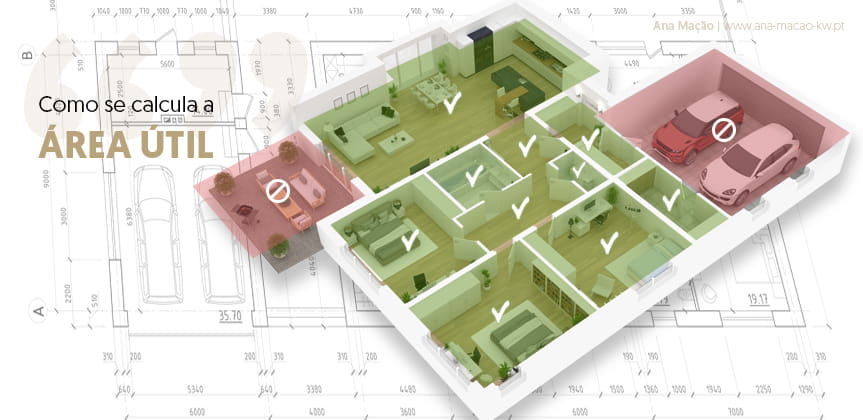Liveable Area
The Liveable Area of a property is one of the most important factors to consider when buying, selling or renting a house. This concept, often misunderstood, has direct implications for the market value of a property and the quality of life of its occupants. In this article, we will explore what floor area is, how it is measured and why it is so important in the real estate sector.
Definition of Liveable Area
The Liveable Area is measured by the interior perimeter of the walls that limit the property, discounting gaps of up to 30 cm, interior walls, partitions and ducts. In simple terms, it is the space where you can actually "live" or "work".
Liveable Area is the sum of the areas of all compartments of a dwelling or commercial space:
- Including: rooms (bedrooms and living rooms), kitchens, lobbies and interior circulations, sanitary facilities, private basements and attics (with use identical to that of the building or fraction), closed balconies, storage or other compartments with a similar function and wall cabinets.
- Excluding: walls (interior and exterior), pillars, partitions, ducts and common spaces (such as corridors and stairs). Non-habitable spaces such as storage rooms, terraces, open balconies, garages or outbuildings, porches, gardens and swimming pools are not part of the Liveable Area (these are part of the Dependent Area).

How to measure the Liveable Area
Traditional Measurement Methods
Direct Measurement: The simplest and most direct method is to use a tape measure to measure the length and width of each compartment and multiply these measurements. Naturally, this task becomes more complicated when the geometry of the different spaces in the house is not rectangular. Instead of the traditional tape measure, nowadays the use of Laser Distance Measurers has become widespread, which have a high degree of precision and can be purchased at prices starting at €100.
Property Plan: If you have access to the property plan with explicit scale or dimensions, calculating the Liveable Area becomes easier, since all measurements will be indicated. If the plan does not mention areas, it is possible to extrapolate all areas and dimensions through applications such as Photoshop, as long as the digitized plan has a scale or some visible measurement.
The property owner does not always have the original plans, and often the copies he has are in poor condition. You can always use city services to obtain a copy of the original plan, deposited by the promoter at the time of the respective licensing.
Note: Properties built before 1951 (when Decree-Law No. 38382 came into force) may not have the architectural project deposited with the Chamber.
Technological Measurement Methods
Measurement Applications: There are several mobile applications that allow you to measure areas using your smartphone's camera. Obviously the results are not the most accurate and depend on the floor pattern, the less smooth the more effective this process will be. But these are a quick alternative. There is also the use of cameras with LIDAR technology. E.g. some cameras used in Virtual Tour production use this technology. It has relative reliability, as deviations of up to 5% in relation to actual measurements are possible.
Professional Services: Companies specialized in real estate valuation use high-precision equipment to measure the usable area, and produce plans to scale, using cameras with laser technology. Architects also carry out this type of survey and prepare the respective plans.
Rules for measuring usable areas
When measuring Liveable Areas, the following are considered:
1) Included areas:
- Delimited by the interior of the walls;
- Under spans with a minimum ceiling height of 2.00 m;
- Occupied by fixed wardrobes;
- Occupied by fireplaces or fixed appliances (e.g., fireplaces) that project outside the plane of the wall;
2) Areas excluded:
- Occupied by pillars, ducts or other constructed elements detached from the perimeter of the compartment;
- Areas with ceiling heights below the regulatory minimum.
In compartments with multiple levels or floors, the Liveable Area includes all floors and the plan area of the interior connecting staircase.
The minimum ceiling height is 2.40 m in housing, 3 m in commerce and services and 2.20 m in parking lots. The following exceptions are permitted:
- Toilets, pantries, storage rooms, lobbies, corridors, storage rooms and storage rooms can be 2.20 m;
- Compartments with special ceilings (slanted, vaulted or false) can have 20% of the area with 2.20m in housing and 2.70m in commerce;
- Spaces intended for administrative services and commerce that result from the change in licensed use may be 2.70 m;
- Attics, attics and mansards may have areas with lower ceiling heights, as long as this occurs: in half of their area and if at all points more than 0.30 m away from the perimeter of the compartment the ceiling height is not less than 2.00 m.
The Liveable Area is expressed in square meters.
Source: Faculty of Economics of Porto
Importance of Liveable Area
Property Valuation
Price per square meter is a common metric in the real estate sector. A correct assessment of the property, carried out by a specialized entity, involves accounting for the 'Liveable Area', as well as the remaining areas.
Sometimes, we come across properties that have a similar Gross Construction Area, but whose Liveable Areas and Dependent Areas differ. The larger the usable area, the more valuable the property will be, given that the Dependent Area has a lower value.
Quality of life
The usable area has a direct impact on the quality of life of the occupants. Larger spaces offer more comfort and freedom of movement. For example, a T3 apartment with 100m2 of living space will offer a different living experience than one with 150m2, although both may be advertised as T3. The difference in usable area can affect everything from space organization to quality of life.
So, if you are looking for a house, keep in mind that, sometimes, property advertisements omit the Liveable Area and only mention the gross construction area. However, in reality, people live and work primarily in residential spaces and not in balconies, storage rooms or garages.
Planning and Decoration
Knowing the usable area is crucial for space planning and decoration. Allows better organization of furniture and decorative elements. Countless times, money and time are lost due to a lack of measurements and areas that allow planning the decoration or adapting furniture transported from the previous house to the new space.
Legislation and Standards
The concept of Liveable Area is written in the General Regulation of Urban Buildings - RGEU - Article 67. Decree-Law No. 38382 :
b) Liveable Area (La) is the sum of the areas of all compartments of the dwelling, including vestibules, interior circulations, sanitary installations, storage, other compartments with a similar function and cabinets in the walls, and is measured by the interior perimeter of the walls that limit the property, discounting obstructions of up to 30 cm, interior walls, partitions and ducts;
It is crucial to be aware of these regulations to avoid legal problems.
Common mistakes regarding the Liveable Area
Confusing Usable Area with Gross Area: The gross area includes walls and other structural elements, which can lead to an overvaluation of the property. When comparing properties that are for sale, this is often a common mistake that inflates the real value of the home, thus harming the buyer. The opposite also occurs, when using the gross area instead of the usable area, which distorts the real value of the property and in this case harms the selling owner.
Consider the Common Areas of the building or condominium: In buildings, the areas common to the different fractions, such as stairs, lobbies, condominium rooms, etc. do not count towards the Liveable Area. In condominiums, the Liveable Area of the property does not include common areas such as gardens and swimming pools.
Confusing the Gross Private Area with the Liveable Area: the first includes walls, columns and other partitions within the perimeter of the house, while the second does not.
Confusing Usable Area with Habitable Area - The latter
Conclusion
Liveable Area is a fundamental concept in the real estate sector that influences both the market value of a property and the quality of life of its occupants. Knowing how to correctly measure the usable area and understanding its importance can make all the difference when buying, selling or renting a property.
On the other hand, to make a well-founded decision when purchasing a property, it is essential to review all documentation related to the property. Make sure that the usable area is clearly indicated and meets your needs and expectations before proceeding with any negotiations.
I hope this article has been enlightening and useful in better understanding this very relevant topic in the real estate world. If you have more questions or need additional clarification, consult the remaining terms in my glossary: The ABC of Real Estate .
Frequently Asked Questions about the Liveable Area

Here are some of the most frequently asked questions about the Liveable Area:
1. What is the Liveable Area?
The Liveable Area is the sum of the areas of all compartments of a dwelling or commercial space, excluding walls, pillars and common spaces such as corridors and stairs. It is the space where you can really "live" or "work".
2. Where to check the Liveable Area of a property?
Checking the usable area of a property is a crucial step in the buying, selling or renting process.There are several sources where this information can be obtained, including the public deed , the architectural plan and the real estate valuation report . The Energy Certificate can also provide data on the Liveable Area.
3. How can I measure the Liveable Area of my house?
You can measure the Liveable Area using a tape measure to measure the length and width of each compartment and multiply these measurements. You can also use mobile measurement applications or use professional services, such as an architect.
4. Why is it important to know the Liveable Area of a property?
The usable area is important in determining the market value of a property and has a direct impact on the quality of life of the occupants. It is also crucial for space planning and decoration.
5. What is the difference between Liveable Area and Gross Area?
The gross area includes walls and other structural elements, while the usable area excludes these elements. The usable area is the space where you can actually "live" or "work".
6. What is the difference between Liveable Area and Private Area?
Basically the difference is that the Private Area includes the thickness of the walls, partitions and pillars, included within the exterior perimeter of the home.
In the Municipal Property Tax Code (CIMI), Decree-Law no. 287/2003 , the definition of Gross Private Area is stated: "The gross private area (Aa) is the total surface measured by the outer perimeter and axes of the walls or other separating elements of the building or fraction, including closed private balconies, basements and private attics with identical use to that of the building or fraction, to which coefficient 1 applies."
7. What happens when real estate advertisements omit the Liveable Area?
Sometimes, property advertisements may omit the usable area and only mention the gross construction area. It is important to be aware of this and request information about the Liveable Area before making any decision. You may be surprised by a smaller housing area than the Gross Construction Area would suggest.
Important Note: The information in this glossary is for informational purposes only. For proper advice on legal or tax matters, consultation with a duly authorized lawyer, notary, solicitor, or accountant is essential.
Your next step in the real estate market
Whether you want to sell your property for the maximum value or find the ideal home, count on my experience as a Top Producer consultant at KW Portugal. Talk to me without obligation. Start today with a simple contact.
Contact Me Today
Related articles






